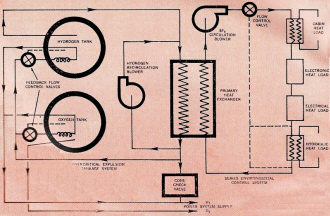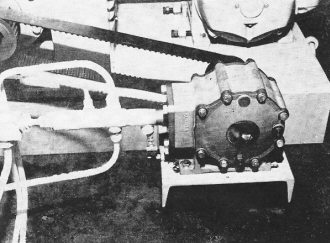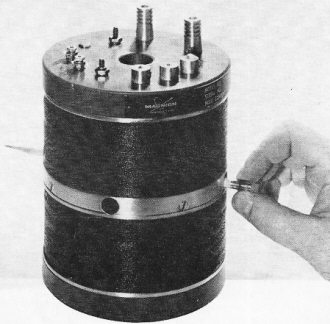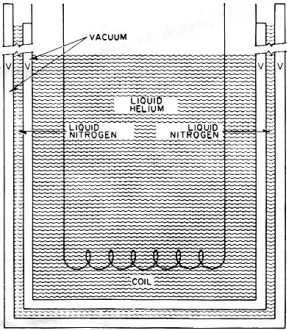Cryogenics in Electronics
|
|
Who knew that Willie Nelson was, in addition to being a top country music star, was also an electronics expert? This article from the December 1965 issue of Electronics World included a feature by William Nelson entitled "Cryogenics in Electronics." OK, so it's probably not the same guy. Per the kTB equation governing the power level of thermal noise in a given bandwidth, thermal noise needs to be as low as possible to enable the smallest possible radio signal. "k" is Boltzmann's constant (1.3806503 × 10-23 m2 kg s-2 K-1), "T" is the temperature in Kelvins, and "B" is the bandwidth (BW) in hertz. If the required BW is fixed, and K is fixed, then T needs to be lowered below the ambient temperature. Cryogenics are required to do the job for meaningful results. Requirement for space exploration and space communications motivated a large scale effort to design extremely high sensitivity receivers. Cryogenics in Electronics Fig. 1 - Special cryogenic systems designed by Kidd Aerospace which utilizes hydrogen and oxygen gases along with sulfur hexafluoride for heat exchange. By William Nelson Important uses for equipment producing ultra-low temperatures include space environment simulation, low-noise amplifiers, and superconducting magnets. By the 100th day after Mariner 2 was launched, with Venus still nine days away, the spaceship temperature had climbed to an alarming average 40°F higher than had been predicted. The battery which supplied power to the electronic system had reached its uppermost limit. The earth-sensor had passed its limit; other electronic systems were approaching limits. Moreover, with solar radiation impinging at greater than 250 watts on each square foot of Venus, the situation could only get worse. This crisis in space came close to aborting one of America's most successful space probes. It came about because there was, at that time, no way on earth to adequately simulate the space environment. Space has no temperature and the heat dissipated by circuits operated in outer space must be removed, just as on earth, to preserve electrical properties and prevent damage. Single-cylinder high-pressure (10,000 psi) cryogenic pump. 50,000-gauss superconducting magnet used to study properties of matter in high magnetic fields at very low temperatures. Recent advances in cryogenics now make space probes more reliable by providing knowledge of outer space effects before the vehicle leaves earth, as well as providing refrigeration for removing heat generated in the vehicle during its voyage into outer space. Cryogenics is the science of low-temperature physics concerned with the behavior of matter at very low temperatures. (Cryogenic temperatures are frequently defined as those below -297° F, the boiling point of liquid oxygen ... Ed.) The function of the cryogenic system is to transfer waste heat from heat sources to a heat sink. Highly specialized refrigeration systems are needed to achieve and maintain cryogenic temperatures. Fundamental to all cryogenic systems is the method of removing heat from the warm high-pressure area and transferring it to the cold low-pressure area. Heat exchangers are used for this purpose and may employ coiled tinned tubing wrapped in a mandrel, resulting in a densely packaged, highly efficient unit. Two methods are available for accomplishing this heat transfer. One makes use of a liquid, ethylene glycol, to effect heat exchange with nitrogen. The other uses a gas, sulphur hexafluoride. These two systems are competitive on a weight basis, the gaseous system offering some control advantages. (See Fig. 1.) The basic cooling cycles used in cryogenic refrigeration are the Joule-Thomson cycle and the expansion-engine cycle. Each exhibits advantages for specific cooling requirements. The Joule-Thomson cycle is the simplest method of providing refrigeration since cold moving parts are not required. Inherent in the use of cryogenic temperatures with electronic systems is the associated design problems of the electronics. Electronic components and fabrication techniques must be able to withstand the ultra-low temperatures; insulation and circuit connections must endure changes from ambient to cryogenic temperatures. It is hard to provide connections which hold together conductors with different thermal expansion coefficients. Contamination, which at cryogenic temperatures causes malfunction of electronics circuits, must be eliminated by special techniques. Insofar as electronic applications of cryogenics are concerned, the sky seems to be the limit. While outer space provides many of the conditions for optimum use, here on earth there seems to be virtually no limit. New types of power generating devices are being designed; cryogenic gyros, motors, and solenoids are already in use. New cryogenic computer elements appear almost daily. One of the earliest applications of cryogenics to electronics was the development of an echo box having a "Q" of about 500,000. This is an unheard of occurrence in equipment operating at ambient temperatures. Recent advances in super-insulation make possible substantial improvements in this early device. many of the latest devices in electronics either must operate at low temperatures or their operating characteristics are considerably improved by such operation. This includes ultra-sensitive detectors, masers, lasers, paramagnetic amplifiers, infrared detectors, diode luminescent devices, new sources of electromagnetic energy, and a host of others. (See Fig. 2.) The time is probably not far distant when many electronic systems will operate at cryogenic temperatures. Fig. 2 - A 70,000-mc. traveling-wave maser system operating at constant cryogenic temperature for improved frequency stability. Fig. 3 - Superconductivity is produced in coil of special wire submerged in liquid helium. Liquid nitrogen at −322°F and the two vacuum chambers keep the helium from boiling off. The entire vessel (called a "Dewar") is made of stainless steel and operates as double-insulated vacuum bottle. One cryogenic system provides a low-temperature environment for stable low-noise parametric amplifier performance for periods of 2500 hours without adjustment or maintenance. Conductive cooling quickly lowers the parametric amplifier system from ambient to the operating temperature when the unit is operated in a vacuum-insulated enclosure. The net refrigeration removes the combined electrical and thermal (conductive and radiant) loads of the amplifier assemblies that are employed. Superconductivity When certain materials are cooled below a critical temperature and close to absolute zero (about -460°F), their electrical resistance approaches zero. As a result, the material becomes a super-conductor of electrical current. Passing an electrical current through a superconductor does not result in any heat being produced. (See Fig. 3.) This phenomenon of superconductivity occurs in many metallic elements and in over 100 different alloys. In a superconducting coil where there is virtually no resistance, a current can be maintained for a year or longer with virtually no excitation. Since the discovery of this phenomenon in 1911, the possibility has been recognized in the use of superconductors for constructing efficient solenoidal magnets. They would require no power and present no problems associated with heat transfer to cooling media. A superconducting magnet consists of a coil of very special wire, such as niobium-zirconium or niobium-tin, which is immersed in a bath of liquid-helium. A t this cryogenic temperature (-452°F) the wire has zero resistance and can carry tremendous d.c. electrical currents (200,000 amp./cm.2) without heating. It is thereby possible to wind very compact, very strong d.c. electromagnets that consume virtually no power and with considerable saving in over-all cost. Most of the applications of superconducting magnets at present are in the area of basic research, particularly physics. Considerable application has also been made in electronics. As the technology develops, there is a definite application to atomic particle accelerators, magnetohydrodynamic generation of electrical power, and countless types of instrumentation. Superconducting magnets are a natural in maser and laser applications since the maser and laser crystals must be at liquid helium temperatures for most efficient operation. In addition, considerable reductions in size and weight are very important for these devices in countless applications in industry and science. In other electronic applications, superconducting magnets can be used for such devices as image-amplifier tubes and electronic microscopes for increased resolution and for traveling-wave tubes where the high magnetic fields will reduce noise. Microwave amplifiers can be designed to work in the gigacycle frequency range by application of cryogenic refrigeration. On the same principle, microwave Dewars are used for the evaluation and measurement of K-band (about 30 gigacycles), microwaves, optical and X-radiation. In a like manner, superconductivity can be instrumental in making possible high-performance computers, microwave radar and communications systems, scientific instruments, high-current storage batteries and magnetohydrodynamic power supplies. A superconductive gyro takes advantage of the fact that, when the resistivity of a superconductor approaches zero, magnetic induction also disappears. As a result, the superconductor will expel a magnetic field. It creates, in effect, a magnetic cushion so that the gyro rotor can float in space. The loss of resistivity keeps power requirements very low and makes for very stable gyro operation. Quenching Superconductivity Most superconductors, however, are quenched when placed in a magnetic field, that is to say, their resistive properties are restored in a magnetic field of even low intensity. The self-bias produced in a solenoid will thereby destroy the desirable superconducting properties. Superconductivity can thus be controlled by magnetic force as well as temperature. This dual property makes an important tool of superconductivity. By this means it is possible to design switches, rectifiers, and flip-flops that are compact and fast-acting, while consuming almost no power. Superconducting rectifiers, for example, are designed so that quenching of the superconductivity in a magnetic field performs the same action as a conventional rectifier. It offers a large impedance to current flow in one direction, with relatively little opposition in the reverse direction. This magnetic quenching has, until recently, limited the application of superconducting solenoids to the production of magnetic fields of only a few kilogauss intensity. The recent discovery of new alloys which remain superconducting in very intense magnetic fields (while carrying currents up to 100,000 amps per square centimeter and above) has relieved this situation. These new alloys lead to the production of magnetic fields that may be in excess of 200 kilogauss. Making use of these new alloys, a new type of power supply depends for its operation on the properties of field strength. Operation of the power supply continues even after the power supply is disconnected from the source of power. Superconductivity does not provide "free" power, however, instead it merely eliminates dissipation of the power so that the maximum amount of work can be performed by it. This absence of dissipation makes it possible for an electrical current to continue to flow almost in-definitely without loss. Interaction Between Superconductors The interaction between superconductors and non-superconductors also promises to pave the way toward new thermal devices such as switches and flip-flops. When copper or another non-superconducting wire is soldered to a superconductor such as tin, thermal resistance at the interface is much greater when the tin is superconducting than when both metals are at ambient temperature. This high junction resistance can be reduced by a factor of 10 to 1 when a magnetic field is applied to the junction. Thermal switches such as this are very sensitive and fast acting. When a coil of superconductive wire is wrapped around a rod of non-super-conductive metal whose resistivity is much larger or smaller than the superconductor, current in the wire can be made to control the resistivity of the rod (or vice versa). Switching can thereby be accomplished to switch from a zero resistance to a finite value and back. Upon this action is based fast-acting switches which find extensive application in computer memory circuits. For use in a memory circuit, the device is immersed in liquid helium, the container (dewar) is vacuum sealed and pressure reduced until the ultra-low temperature (in the vicinity of -452°F) is achieved. Circuit wires introduced into the Dewar through vacuum inlet tubes are connected to computing equipment operating at ambient temperature. Cryogenics' Future Future developments will allow fast and efficient superconducting materials to be used in countless electronics applications. Superconductivity provides the means for designing new devices having greater efficiency than with any previously known electronics techniques. In addition, it brings about new knowledge that will improve the design of conventional equipment.
Posted November 17, 2022 |
|





